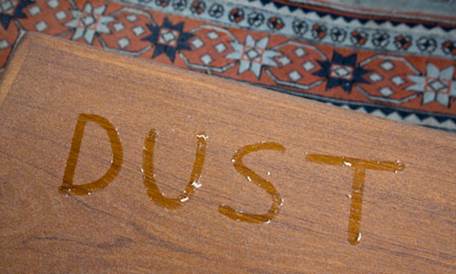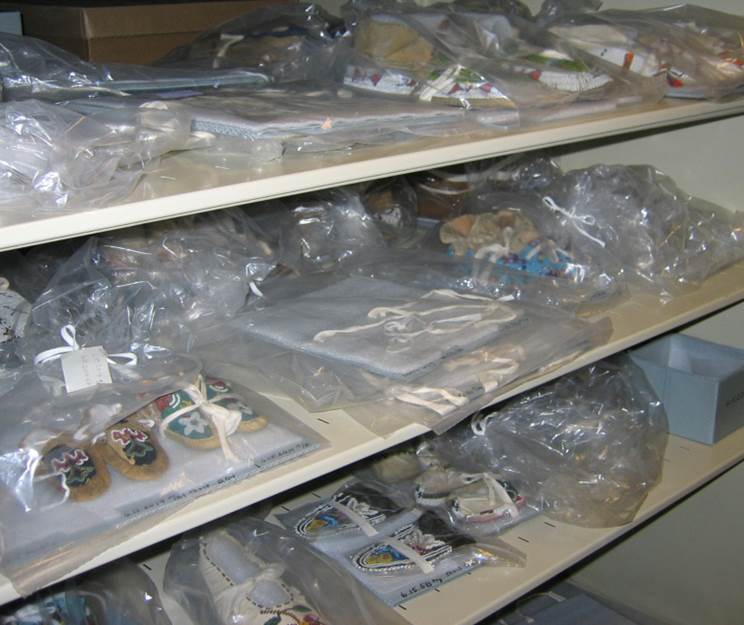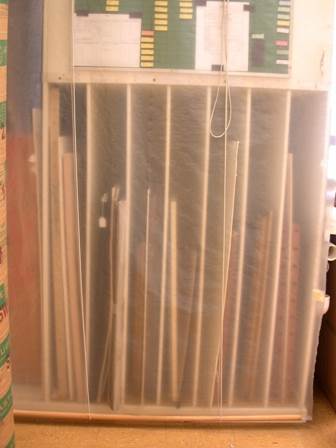By Marcelle Lunau
 Wrapping or boxing or leaving…How do we decide what to do when we want to protect our cultural heritage? And which plastics are safe to use?
Wrapping or boxing or leaving…How do we decide what to do when we want to protect our cultural heritage? And which plastics are safe to use?
Recently I had a conversation with participants at the Balboa Art Conservation Center (BACC) Focus on Collections workshops in Tempe about whether or not plastics are safe to use for wrapping leather objects in storage. In this case, we were looking at beaded American Indian moccasins. Some people argued that the plastic would increase the possibility of mold, and other people were doubtful. This is a very good question, and I am going to dive a little further into the practical considerations and spread some light on “wrapping or not” as well as “with what”.
Firstly, the mold question. When you have a stable object that is stored in a stable environment, the object can actually be safely wrapped in plastic sheeting or a plastic bag. The object will adjust to the “micro-climate” that is within the plastic and objects made of organic materials will buffer themselves. This is true for objects that are placed in an environmentally controlled storage area. The benefit of the plastic wrapping is that it protects the enclosed items from dust and pests. In case of the moccasins, it is a good idea is to also support them in a way that will allow you to carry them safely, this can be done by tying them with twill tape to an acid-free mat board (or a rigid acrylic sheet) using unbuffered tissue paper between the board and the shoes as well as around and inside the shoes. THEN put the wrapped and supported moccasins into a protective bag. This procedure will not only protect the object, but also allow you to move it safely.

Plastic wrapping for moccasins
Secondly, which plastics to use? One should distinguish between plastics which are safe and those that are not. You need to avoid plastics treated with anti-slip agents, and be sure that they do not contain plasticizers, solvents, or other additives that might affect the object.
For example, PVC, Polyvinyl Chloride, should NOT be used in any form, as it emits damaging by-products. Polyurethane turns into a powder as it ages, so that is definitely not a safe product to use, and one should be cautious and not use bubble-wrap directly up against museum objects since the bubbles might leave an imprint on vulnerable surfaces, such as varnishes.
There are actually only three types of plastics that meet preservation standards. These are polypropylene, polyethylene and polyester (polyethylene terepthalate commonly called PET film). These can fortunately be bought in many forms; thick, thin, soft, hard sheets, rolls and foams, and are sold under many trade names. Be sure to purchase them from reputable suppliers who can provide you with specific information about the product. Of course, just like polypropylene and polyethylene, only polyesters that are free of plasticizers, ultraviolet inhibitors, dyes and surface coatings should be used…so be sure to read the catalogue descriptions before buying your storage products!
A different way to keep dust out is to cover the shelving with dust covers. Polyethylene sheeting is clear and a good moisture barrier, and is easy to get at the local hardware store.

A polyethylene plastic sheeting dustcover for paintings
The covers can be attached in various ways to fit your needs. When creating covers for shelving, a good seal is important so that the dust actually stays out, but you also need to think about accessibility. How often are the objects going to be needed? At BACC, we cover our storage bins with polyethylene sheeting and a pulley system that allows us to raise the plastic when we need access to the paintings. They are easy to raise and lower and you can see through them.
To wrap it up, using the right kind of plastic is generally great for preserving objects, but when in doubt consult a conservator.
Marcelle Lunau joined BACC in 2014 as Field Service Officer. Marcelle earned her MS in Information Science form Copenhagen University, specializing in Conservation Outreach. In addition she holds a BA in Paintings Conservation from Istituto per l’Arte e il Restauro in Florence, Italy and has several years of experience working as a paintings conservator in European and American museums.








Comments
polypropylene, plyellylene, polyestor (PET fim)
I have a quilt. The top was made in the late 1800's. I want to display the quilt, but want to put a cover on it to keep the dust off. Could you give me places where the materials can be purchased. Thank you
Add new comment